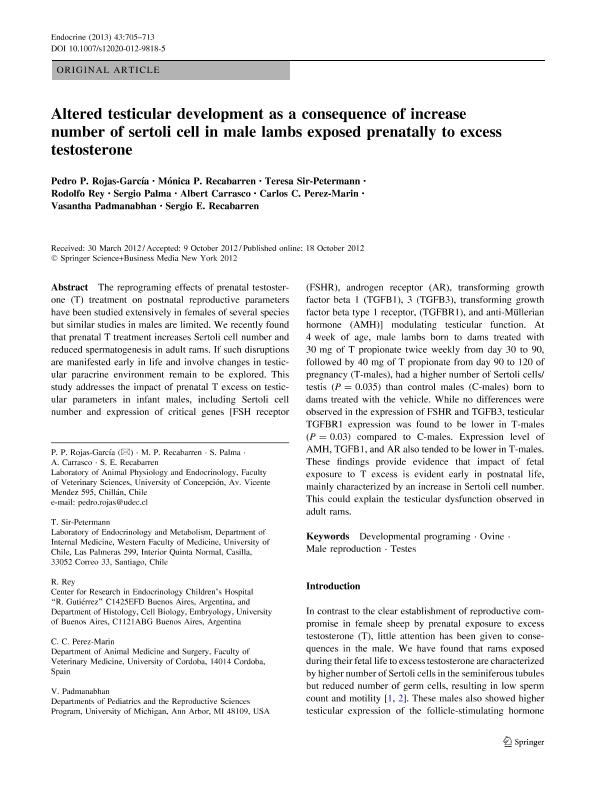Mostrar el registro sencillo del ítem
dc.contributor.author
Rojas García, Pedro P.
dc.contributor.author
Recabarren, Mónica P.
dc.contributor.author
Sir Petermann, Teresa
dc.contributor.author
Rey, Rodolfo Alberto

dc.contributor.author
Palma, Sergio
dc.contributor.author
Carrasco, Albert
dc.contributor.author
Pérez Marín, Carlos C.
dc.contributor.author
Padmanabhan, Vasantha
dc.contributor.author
Recabarren, Sergio E.
dc.date.available
2016-11-10T20:25:22Z
dc.date.issued
2013-06
dc.identifier.citation
Rojas García, Pedro P.; Recabarren, Mónica P.; Sir Petermann, Teresa; Rey, Rodolfo Alberto; Palma, Sergio; et al.; Altered testicular development as a consequence of increase number of sertoli cell in male lambs exposed prenatally to excess testosterone; Humana Press; Endocrine; 43; 3; 6-2013; 705-713
dc.identifier.issn
0969-711X
dc.identifier.uri
http://hdl.handle.net/11336/8134
dc.description.abstract
The reprograming effects of prenatal testosterone (T) treatment on postnatal reproductive parameters have been studied extensively in females of several species but similar studies in males are limited. We recently found that prenatal T treatment increases Sertoli cell number and reduced spermatogenesis in adult rams. If such disruptions are manifested early in life and involve changes in testicular paracrine environment remain to be explored. This study addresses the impact of prenatal T excess on testicular parameters in infant males, including Sertoli cell number and expression of critical genes [FSH receptor (FSHR), androgen receptor (AR), transforming growth factor beta 1 (TGFB1), 3 (TGFB3), transforming growth factor beta type 1 receptor, (TGFBR1), and anti-Mullerian hormone (AMH)] modulating testicular function. At 4 week of age, male lambs born to dams treated with 30 mg of T propionate twice weekly from day 30 to 90, followed by 40 mg of T propionate from day 90 to 120 of pregnancy (T-males), had a higher number of Sertoli cells/ testis compared to C-males. Expression level of AMH, TGFB1, and AR also tended to be lower in T-males. These findings provide evidence that impact of fetal exposure to T excess is evident early in postnatal life, mainly characterized by an increase in Sertoli cell number. This could explain the testicular dysfunction observed in adult rams.
dc.format
application/pdf
dc.language.iso
eng
dc.publisher
Humana Press

dc.rights
info:eu-repo/semantics/openAccess
dc.rights.uri
https://creativecommons.org/licenses/by-nc-sa/2.5/ar/
dc.subject
Developmental Programing
dc.subject
Ovine
dc.subject
Male Reproduction
dc.subject
Testes
dc.subject.classification
Fisiología

dc.subject.classification
Medicina Básica

dc.subject.classification
CIENCIAS MÉDICAS Y DE LA SALUD

dc.title
Altered testicular development as a consequence of increase number of sertoli cell in male lambs exposed prenatally to excess testosterone
dc.type
info:eu-repo/semantics/article
dc.type
info:ar-repo/semantics/artículo
dc.type
info:eu-repo/semantics/publishedVersion
dc.date.updated
2016-11-10T13:49:14Z
dc.journal.volume
43
dc.journal.number
3
dc.journal.pagination
705-713
dc.journal.pais
Estados Unidos

dc.journal.ciudad
Oregon
dc.description.fil
Fil: Rojas García, Pedro P.. Universidad de Concepción; Chile
dc.description.fil
Fil: Recabarren, Mónica P.. Universidad de Concepción; Chile
dc.description.fil
Fil: Sir Petermann, Teresa. Universidad de Santiago de Chile; Chile
dc.description.fil
Fil: Rey, Rodolfo Alberto. Consejo Nacional de Investigaciones Científicas y Técnicas. Oficina de Coordinación Administrativa Parque Centenario. Centro de Investigaciones Endocrinológicas; Argentina
dc.description.fil
Fil: Palma, Sergio. Universidad de Concepción; Chile
dc.description.fil
Fil: Carrasco, Albert. Universidad de Concepción; Chile
dc.description.fil
Fil: Pérez Marín, Carlos C.. Universidad de Córdoba; Argentina
dc.description.fil
Fil: Padmanabhan, Vasantha. University Of Michigan; Estados Unidos
dc.description.fil
Fil: Recabarren, Sergio E.. Universidad de Concepción; Chile
dc.journal.title
Endocrine

dc.relation.alternativeid
info:eu-repo/semantics/altIdentifier/url/http://link.springer.com/article/10.1007%2Fs12020-012-9818-5
dc.relation.alternativeid
info:eu-repo/semantics/altIdentifier/doi/http://dx.doi.org/10.1007/s12020-012-9818-5
Archivos asociados
